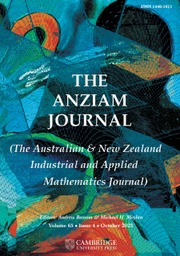No CrossRef data available.
Article contents
On the implementation of a subset selection algorithm for the restricted least squares problem
Published online by Cambridge University Press: 17 February 2009
Abstract
Core share and HTML view are not available for this content. However, as you have access to this content, a full PDF is available via the ‘Save PDF’ action button.
By noting that it is possible to interchange the roles of the solution vector x and the vector of Lagrange multipliers λ in the restricted least squares problem we are able to give a very efficient implementation of Clark's subset selection algorithm. Numerical results are presented for several selection heuristics.
- Type
- Research Article
- Information
- Copyright
- Copyright © Australian Mathematical Society 1980
References
[1]Armstrong, R. D. and Frome, E. L., “A branch-and-bound solution of a restricted least squares problem”, Technometrics 18 (1976), 447–450.CrossRefGoogle Scholar
[2]Bartels, R. H., Golub, G. H. and Saunders, M. A., Nonlinear programming (Academic Press, 1970), pp. 123–176.CrossRefGoogle Scholar
[3]David, Clark, “An algorithm for solving the restricted least squares problem”, J. Austral. Math. Soc. B 21 (1980), 345–356.Google Scholar
]4]Effroymson, M. A., Numerical methods for digital computers (Wiley, 1960), pp. 191–203.Google Scholar
[5]Gill, P. E., Golub, G. H., Murray, W. and Saunders, M. A., “Methods for modifying matrix factorizations”, Math. Comp. 28 (1974), 505–535.CrossRefGoogle Scholar
[6]Golub, G. H., “Numerical methods for solving linear least squares problems”, Num. Math. 7 (1965), 206–216.CrossRefGoogle Scholar
[7]Golub, G. H. and Wilkinson, J. H., “Note on the iterative refinement of least squares solutions”, Num. Math. 9 (1966), 139–148.CrossRefGoogle Scholar
[8]Jennings, L. S. and Osborne, M. R., “A direct error analysis for least squares”, Num. Math. 22 (1974), 325–332.CrossRefGoogle Scholar
[9]Osborne, M. R., “On the computation of stepwise regressions”, Austral. Computer J. 8 (1976), 61–68.Google Scholar


